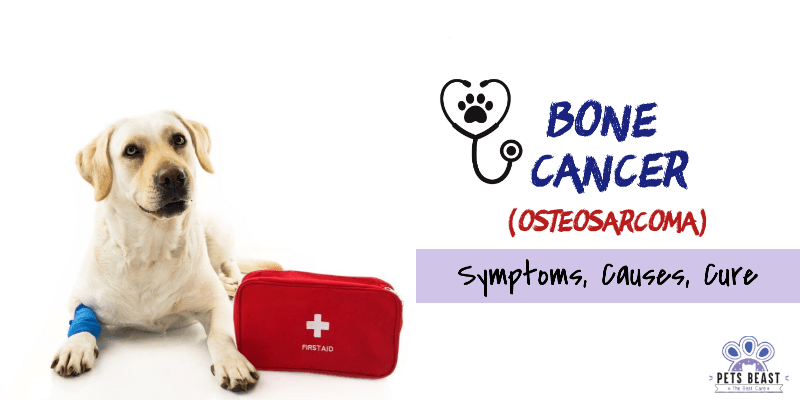Cancer is the abnormal cell growth that may or may not invade other parts of the body i.e. it may be malignant or benign. Bone cancer is one of the most prevailing types of cancer in dogs. Each year almost 10000 dogs are diagnosed with bone cancer, the most common type being osteosarcoma (OSA). The other ones being; haemangioma-sarcoma, chondrosarcoma, and fibro-sarcoma.
[box type=”shadow” align=”” class=”” width=””]Osteosarcoma: Bone Cancer in Dogs

Osteosarcoma starts within the bone itself and does not metastasize from any other body part, hence it is known as Primary bone cancer. However, it has a tremendous ability to metastasize to the rest of the body. Frequently, secondary tumors grow in the lungs and other bones. This may sound a little aggressive but it does help in the early diagnosis and therefore the treatment can be started before it gets too late.
Osteosarcoma or bone cancer is mostly appendicular i.e. in long bones e.g. those of the fore and hind limbs but can be in skull, ribs, or jaw. It may also be extra-skeletal, attacking the liver, kidneys, or spleen. The appearance of the tumors is common at the site of joints of the animal i.e. wrists, knee, or shoulder. As cancer progresses, secondary tumors start to form in other areas too. In such instances, the signs and symptoms are easier to detect.[/box]
[box type=”shadow” align=”” class=”” width=””]Signs and Symptoms of Bone Cancer in Dogs
1). Local Swelling or a lump on the limb
A swelling if mostly the easiest and early signs to detect on the limb. Swelling indicates lymphedema due to the accumulation of fluid underneath the skin. This is a common symptom for all types of cancer in which tumors cause blockage of the lymph preventing the adequate drainage and hence the localized swelling.
2). Inflammation, Redness, and Warming of the area
Inflammation can be the cause or effect of cancer. It is due to tissue injury at the site of tumor growth. If, while patting your dog, you find a red swollen area, don’t ignore it. Even if this redness is left unnoticed, the warmth of this area would surely make it be noticed. It might not be cancer but redness does pave way for diseases.
3). Persistent lethargy, inactivity or dull behavior without any apparent cause
As in humans, cancer drains the energy from the body just like we wring water from clothes. In dogs too, cancer causes extreme fatigue and your dog may seem dull in such a case.
4). Lameness even after ample rest and painkillers
Due to exhaustion, your pet may present with loco-motor dysfunction. You likely assume it to be a temporary condition due to a lack of rest. But if this lameness does not resolve even after rest, consult a vet asap.
5). Restlessness and extreme pain often unbearable
Cancer causes significant pain. Just because your pet can’t rate it does not means it doesn’t feel it. Many dogs conceal their pain exceptionally well so you do need to be vigilant about its behavioural changes.
6). Sudden change in behaviour
Subtle changes in such cases are an outcome of pain that your dog is enduring. Painkillers might help in the early days.
7). Loss of appetite
It is too, a sign of restlessness and pain your dog is trying to hide well.
8). Frequent fractures
Bone tumors destroy the cortex of the bones. “Moth-eaten” or lytic bones are seen in X-Ray. If the bones have deteriorated, dogs may present with fractures even after minor injuries.
9). Gait disturbances
As bone cancer significantly affects the limbs, there is a wobble in the gait of your dog. Lameness and lethargy are also seen.
10). Abnormal breathing, shivering, and convulsions
Lungs are the first station to be attacked if the OSA metastasizes. Therefore, the pet may be having difficulty in breathing. As the other organs are also gradually degenerating, seizures are also observed in extreme cases.
Axial OSA may manifest as:
- Bad breath
- Changes in facial symmetry
As OSA affects the skull, they lose their bone mass. This leads to changes in the features of the facial bones and hence, you will notice slight changes in the facial features and symmetry. For instance, Jawbones would appear to be strangely abnormal.
Seizures in case of Spinal OSA. As cancer in the backbone would severely compress the neuronal structures, it would lead to neurological instability, convulsion, and seizures. In milder conditions, your dog will find it difficult to walk.
Bloody gums or specks of blood in leftover food. This indicates that your dog is bleeding internally, most probably somewhere above its upper bowel.
Swellings on chest. As the ribs can also be invaded by tumor cells, the overlying skin may swell and can easily be detected. [/box]
[box type=”shadow” align=”” class=”” width=””]Diagnosis of Bone Cancer in Dogs
Usually, definitive diagnosis is made by:
- Physical examination
- X-Ray
- CT-Scan
- Urinalysis
- Abdominal ultrasound
- Tissue biopsy
- FNAC is also a quick and safe method to do so.
It would allow the veterinary surgeon to know if there is any other option than surgery. However, in the cases in which pets have intractable pain, the diagnosis may not be easier before amputation.
As far as the diagnosis is concerned, it is solely the job of the veterinarians. So, it would be wise to trust the surgeon in this matter.[/box]
[box type=”shadow” align=”” class=”” width=””]Causes of Bone Cancer in Dogs
The exact cause is still unknown as it is multifactorial, but after observing the increased prevalence in giant dog breeds, it can be deduced that it is associated with the genes that interfere with the growth of tumor cells.
Bone cancer is most prevalent is giant dog breeds(their weight exceeding 99 lbs.) such as Rottweiler, Great Dane, German Shepherd, Saint Bernard, Labrador retrievers, etc.
Among the 10,000 of the dogs diagnosed with bone cancer yearly, more than 95% of them are those suffering from osteosarcoma.[/box]
[box type=”shadow” align=”” class=”” width=””]Treatment of Bone Cancer in Dogs
It is very important to understand that by the time OSA or any other cancer is diagnosed, it has certainly already metastasized. Therefore prevention is no more an option. In the early stages, home care is a good idea if the consultant gives permission and oral drugs are used.
While the veterinary patient’s assessment, it is important to take the consent of the owner and get to the owner’s therapy goals. The owner has to choose between curative or palliative measures. It is also important to know the owner’s limitations beforehand.
It has to be worked out that most of the cancer treatments don’t truly cure cancer but manage the pain and slow down the spread to extend the life span.
Oral Medications
NSAIDs, Adjuvant analgesics, or Opioids can be used for pain relief. However, the use of opioids is controversial. As far as other oral pain medications are concerned, the animal stops responding to them after prolonged use.
Bisphosphonate injections
It works by inhibiting osteoclasts and thus reducing bone destruction. It reduces the risk of fractures, alleviates pain well, and has to be administered every month.
Palliative radiation treatment
It is highly accurate and targets tumor cells causing little damage to healthy tissue. Proper protocol with home care and bisphosphonate is needed too.
Amputation
It relieves pain and is the most reliable method to cease the spread of cancer however, most owners don’t allow.
Limb-sparing surgery
In this method, part of the limb with the tumor is removed instead of amputation.
Chemotherapy
It is pursued post-surgery to control the disease.[/box]
Prognosis
- Oral medications solely, fail to work after a month or two as the animal becomes unresponsive to them afterward.
- Life expectancy can increase if the dog is injected with bisphosphonates along with radiation therapy. SRT has a good prognosis.
- Amputation manages pain well for 5 to 6 months but the spread of cancer eventually results in demise.
- Chemotherapy has an excellent prognosis and the animal can live up to 1 year or more. Survival rates are almost 100%.



